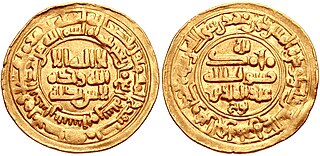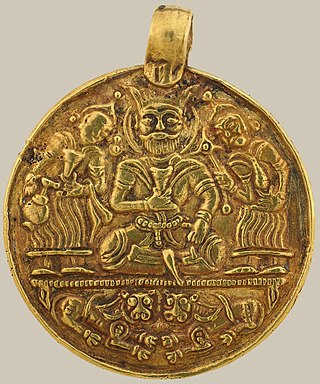Related Research Articles

The Samanid Empire, also known as the Samanian Empire, Samanid dynasty, Samanid amirate, or simply as the Samanids, was a Persianate Sunni Muslim empire, of Iranian dehqan origin. The empire was centred in Khorasan and Transoxiana; at its greatest extent encompassing Persia and Central Asia, from 819 to 999.

The Ziyarid dynasty was an Iranian dynasty of Gilaki origin that ruled Tabaristan from 931 to 1090 during the Iranian Intermezzo period. The empire rose to prominence during the leadership of Mardavij. After his death, his brother Vushmgir and his Samanid allies led the dynasty in wrestling for control over territory against the Buyids in the early- to mid-10th century. When Vushmgir died, his sons Bisutun and Qabus fought for influence. Qabus would eventually outlive his brother and ruled the kingdom. However, Qabus was placed in exile from 980 to 998 by the Buyid ruler, Adud al-Dawla who would then dominate Tabaristan, the heartland of Ziyarid power. A succession of other rulers came to rule the kingdom with Ghaznavid support in the early 11th century. The Nizari Ismaili state invaded and ended Ziyarid rule in 1090.

Abd al-Malik I was amir of the Samanid Empire from 954 to 961. He was the son and successor of Nuh I. His reign was marked by internal strife, with the Turkic slave-soldiers increasing in power. He died after falling from his horse during a game of polo at Bukhara. He was succeeded by his brother Mansur I, who was put on the throne by a faction of ghulams led by the Turkic slave-commander, Fa'iq Khassa.

Nuh ibn Nasr, or Nuh I, was the Amir of the Samanids in 943–954. He was the son of Nasr II. It is rumoured that he married a Chinese princess.

Abu Salih Mansur, better known as Mansur I (منصور) was amir of the Samanids from 961 to 976. The son of Nuh I, his reign was characterized by weak rule and perpetual financial troubles. Mansur was notably the first Samanid ruler to the use title of King of Kings (Shahanshah), most likely as a response to his rival, the Buyid ruler Adud al-Dawla, who likewise used the title. He is also known by the sobriquet Amīr-i Sadid.

Hasan, better known by his laqab as Rukn al-Dawla, was the first Buyid amir of northern and central Iran. He was the son of Buya.

Abu Mansur Buya, better known by his honorific title of Mu'ayyad al-Dawla was the Buyid amir of Hamadan (976–983), Jibal (977–983), Tabaristan (980–983), and Gorgan (981–983). He was the third son of Rukn al-Dawla.

Nasr ibn Ahmad or Nasr II, nicknamed "the Fortunate", was the ruler (amir) of Transoxiana and Khurasan as the head of the Samanid dynasty from 914 to 943. His reign marked the high point of the Samanid dynasty's fortunes. He was the son of Ahmad ibn Isma’il.

Fannā (Panāh) Khusraw, better known by his laqab of ʿAḍud al-Dawla was an emir of the Buyid dynasty, ruling from 949 to 983, and at his height of power ruling an empire stretching from Makran to Yemen and the shores of the Mediterranean Sea. He is widely regarded as the greatest monarch of the dynasty, and by the end of his reign he was the most powerful ruler in the Middle East.

Alp-Tegin, or Alptekin, was a Turkic slave commander of the Samanid Empire, who would later become the semi-independent governor of Ghazna from 962 until his death in 963.

Chaghaniyan, known as al-Saghaniyan in Arabic sources, was a medieval region and principality located on the right bank of the Oxus River, to the south of Samarkand.

Abu Ali Ahmad Chaghani was the Muhtajid ruler of Chaghaniyan (939–955) and governor of Samanid Khurasan. He was the son of Abu Bakr Muhammad.
Abu 'l-Fadl Muhammad ibn Abi Abdallah al-Husayn ibn Muhammad al-Katib, commonly known after his father as Ibn al-'Amid was a Persian statesman who served as the vizier of the Buyid ruler Rukn al-Dawla for thirty years, from 940 until his death in 970. His son, Abu'l-Fath Ali ibn Muhammad, also called Ibn al-'Amid, succeeded him in his office.
Simjur al-Dawati was a 10th-century Turkic general who served the Samanids. He was the founder of the Simjurid family which would play an important role in the Samanid Empire.
Al-Hasan ibn al-Fairuzan was a Daylamite prince from the Firuzanid family.
Ibrahim ibn Ahmad, was the amir of the Samanids briefly in 947. He was the son of Ahmad Samani.
Abu Mansur Muhammad ibn 'Abd al-Razzaq ibn 'Abdallah ibn Farrukh, also simply known as Abu Mansur Muhammad and Ibn 'Abd al-Razzaq, was an Iranian aristocrat who served the Samanids during the most of career, and briefly served as governor of Azerbaijan under the Buyids.
Ali ibn Kama, the uncle of the Buyid ruler Rukn al-Dawla and the latter's other brothers Mu'izz al-Dawla and Imad al-Dawla, was a Buyid military officer who became prominent among the Buyids of Jibal, and was greatly honored among his Daylamite kinsmen. At the death of Imad al-Dawla in 949, Ali was appointed as the viceroy of Ray by Rukn al-Dawla, who went to Shiraz to secure the succession of his son there, Adud al-Dawla. Meanwhile, the Samanids used this opportunity to invade the territories of Rukn al-Dawla, forcing Ali to flee from Jibal. About 959, a battle ensured between Ali and the Ziyarid prince Bisutun, which resulted in a Buyid victory. In 966, Ali and Rukn al-Dawla defeated a large force of ghazis who had arrived from Khorasan. Rukn al-Dawla later died in 976 and was succeeded by his son Fakhr al-Dawla, who had Ali executed.
Ibrahim ibn Simjur was a Samanid military officer from the Simjurid family.
Abu Mansur Lashkarwarz ibn Sahlan, better known as simply Lashkarwarz, was a Daylamite military officer who served the Buyid dynasty. He was the son of a certain Sahlan, and had a brother named Musafir. Lashkarwarz is first mentioned in participating in the army of the Buyid vizier Abu Muhammad al-Hasan al-Muhallabi in the defense of Basra against the Wajihid ruler of Oman, Yusuf ibn Wajih. In 954, Lashkarwarz was sent to aid the Muhtajid ruler Abu 'Ali Chaghani, whose claims to Samanid Khorasan was supported by the Buyids. However, this attempt turned fruitless, and Abu 'Ali died one year later of disease. Lashkarwarz also had a daughter who married the son of the Buyid ruler Mu'izz al-Dawla, Izz al-Dawla. Lashkarwarz along with his brother died in 958.
References
- ↑ Amedroz & Margoliouth 1921, p. 146.
- 1 2 Amedroz & Margoliouth 1921, p. 150.